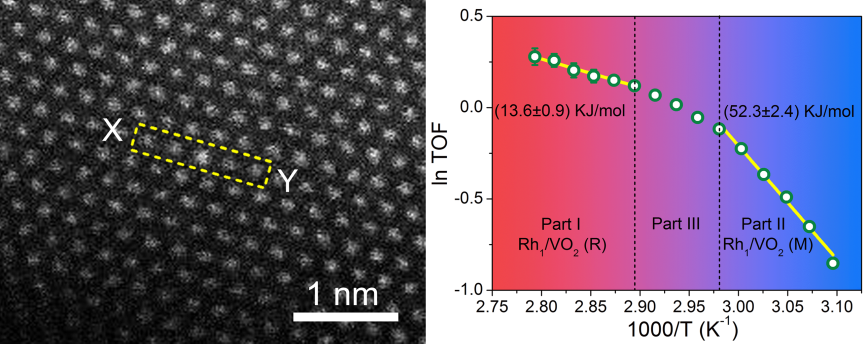
Supported metal nanocrystals demonstrate excellent catalytic performance in hydrogen generation reactions, and the performance is influenced and even determined by their supports. Therefore, uncovering direct relationship between catalytic performance and metal-support interactions is of fundamental significance.
However, it remains a challenge to quantitatively understand the nature of metal–support interactions because scientists still know little about reaction processes in hydrolysis reactions and cannot locate active sites at the atomic level.
Prof. ZENG Jie's group from the University of Science and Technology of China (USTC) has achieved a quantitative profile for exploring metal-support interactions by considering the highest occupied state in single-atom catalysts.
This breakthrough realizes a guideline of generating hydrogen with efficient and inexpensive catalysts by controlling the band structures of the catalysts.

Figure. Rh1/VO2 single-atom catalysts and their catalytic performance (Image by ZENG Jie)
State-of-the-art single-atom catalysts are proposed to be one of the ideal platforms to quantitatively learn about the nature of metal–support interactions, because they are free from interference from the size, shape, and orientation of the metal particles at the metal–support interface.
Thus a single-atom catalyst consisted of isolated Rh atoms uniformly dispersed on the surface of VO2 nanorods (denoted as Rh1 /VO2) has been constructed by the researchers.
Phase transitions of the substrate cause changes in the activation energy during NH3BH3 hydrolysis. With further experimental analysis and DFT calculations, the researchers find that the catalytic performance directly correlates with the highest occupied state of the individual Rh atoms, and the performance in turn depends on the band structure of the substrate.
What's more, other metal catalysts, even with non-noble metals, exhibit significant catalytic activity based on the aforementioned reaction mechanism, and the catalytic activity towards NH3BH3 hydrolysis were rationally designed by adjusting their highest occupied states.
Therefore, controlling the band structure can provide a guideline for the rational design of efficient and inexpensive catalysts towards hydrogen generation.
This work was published on Angewandte Chemie International Edition entitled "The Highest Occupied State of Rh Single Atoms Controls the Catalytic Properties towards Ammonia Borane Hydrolysis".
This work was supported by MOST of China, and the National Natural Science Foundation of China.

86-10-68597521 (day)
86-10-68597289 (night)

86-10-68511095 (day)
86-10-68512458 (night)

cas_en@cas.cn

52 Sanlihe Rd., Xicheng District,
Beijing, China (100864)

